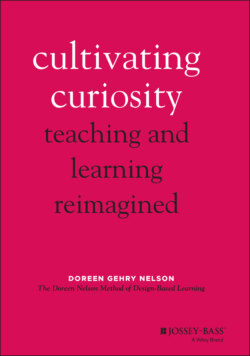Читать книгу Cultivating Curiosity - Doreen Gehry Nelson - Страница 15
CHAPTER 2 SHAPING THE METHODOLOGY
ОглавлениеThe origins of what grew into the Doreen Nelson Method of Design-Based Learning with its 6½ Steps of Backwards Thinking™ was rooted in my conviction that students could learn to express themselves and become decision-makers able to envision the future and advocate for a healthy, equitable society. What I had to figure out first, however, was key: how to teach students to access the higher-level thinking associated with creative and critical thinking so that they would achieve Non-Specific Transfer of Learning, agilely using and reusing concepts and big topics in different settings. (Much later, I faced a bigger hurdle: how to teach what I had discovered to other teachers.)
I researched learning theory for my master's degree in education to see how experts proposed achieving Non-Specific Transfer of Learning. I looked for answers from my hero educators (John Dewey, Benjamin Bloom, and Jerome Bruner), who wrote about teaching for profound learning. Bruner said that creative thinking was central to the growth of all thinking. I found an epiphany in his book, The Process of Education, written in 1960 after the then–Soviet Union's launching of Sputnik. Bruner described what was needed in the teaching of math and science if the United States were to move ahead of the Soviets. He claimed that to do this, educators needed a structure for teaching higher-level, creative thinking. What he said next jumped out at me. “The heart of the creative process,” he wrote, was to have “courage of taste,” and that educators would have greater knowledge of the entire learning process if it were possible to discover what transpired during what he called “leaps of insight.” But, he also wrote that evaluating that would be too hard. Here was my hero telling me that something so important was impossible.
Addressing Bruner's skepticism would become my mission. I would teach creative thinking as a systematic process to activate the higher-level thinking skills that lead to Non-Specific Transfer of Learning. I would teach students how to reason, rather than having them spend most of their instructional time being told what others have reasoned. To capture students' imaginations, I would envision a comprehensive sequence of curriculum-based experiences from simple to complex, set in a “story” sequence that would ask students to imagine, build, and revise original artifacts to display their thinking about serious subject matter. This process, I believed, would make Non-Specific Transfer of Learning easily teachable, would lead to notably improved test scores, meet all of the requirements for college admission, and at the same time promote individuality and self-confidence.
(In December, 2015, I visited Jerome Bruner at his home in New York. Then a remarkable 100-year-old, Jerry said that The Process of Education was his most important book, and that “teaching creative thinking is more urgent than ever.”)
Bloom's Taxonomy describes the teaching of creative thinking and the creation of original things as the culminating goal in educating students. I had been trained to apply the Taxonomy, a common resource in teacher training and staff development, by starting with teaching what was needed to meet the strict requirements imposed by fact-based testing. In my early years as a teacher, before I visualized my reverse “Learning Ladder” in the development of my Backwards Thinking™ method of Design-Based Learning (see Chapter 4), I had followed the prescribed order of the Taxonomy, teaching my students to summarize information, to organize what they learned, and to compare and contrast different examples of information that they acquired. Teaching students to become original thinkers with the ability to envision the future was relegated to the end of the learning process, and like most teachers, I had such a full plate that the ultimate goal of eliciting creative thinking became out of necessity, an afterthought.
I began thinking about how I might teach differently to cultivate students' ability to understand, retain, and reuse universal concepts and principles based on Essential Questions in different settings. I wanted learners to think about thinking, to observe their own thought processes, to know what they knew in order to reuse it—to achieve metacognition. I wondered how I could speed up the learning process and get to the end goal of the Taxonomy earlier, while systematizing teaching students to become fluid, creative thinkers.
To bring to life the theoretical basis for my master's thesis on Non-Specific Transfer of Learning, I proposed teaching students to make reasoned changes to what already existed so they would gain the ability to transfer learning from one setting to another.
